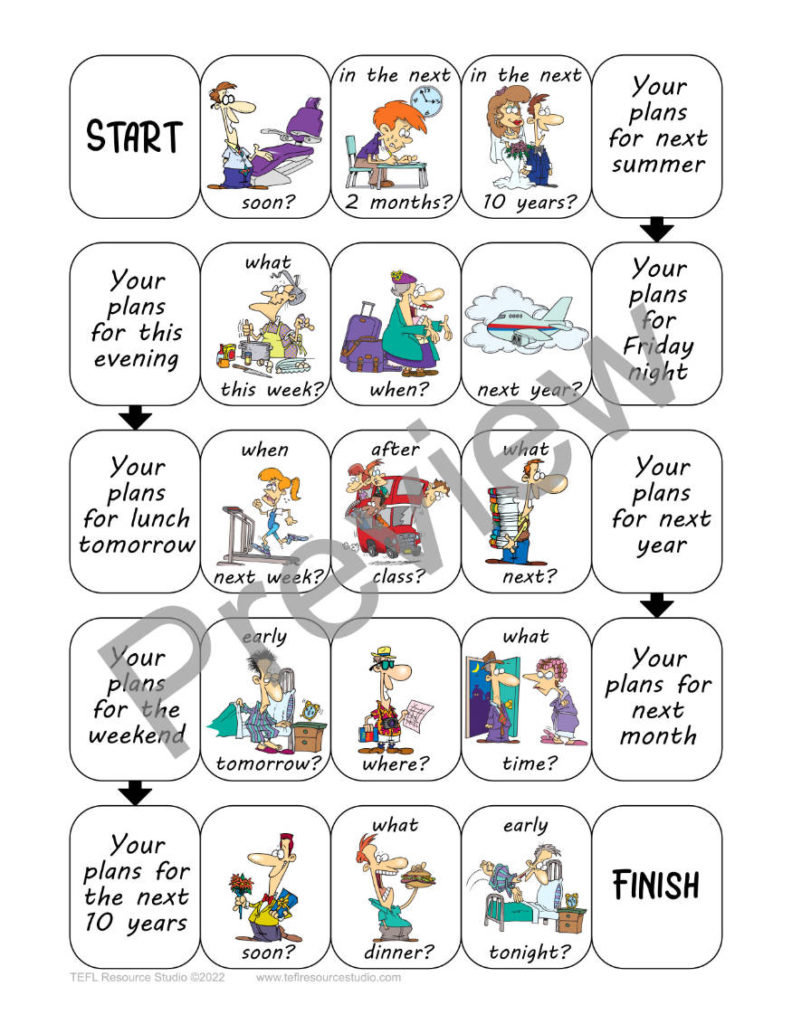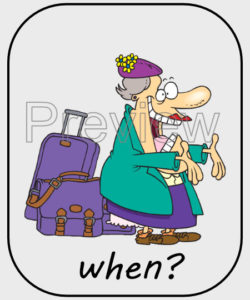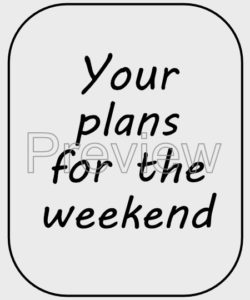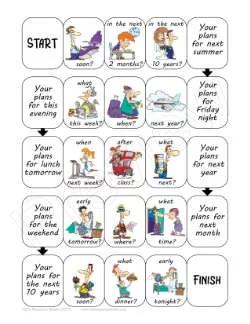The Problem
I’ve been teaching a long time, and during that time one thing that has eluded me is a good board game for practising the future tense. It’s crazy – there are so many board games for practising other tenses and structures (such as conditionals) that you can easily find something to incorporate into your lesson plan. And yet, a good future board game remains elusive.
‘What are you talking about?’ I hear you cry – there are lots of board games for practising future tenses – just do a quick web search and you’ll find something. True, there are board games for practicing future tenses – note the plural of tenses. Some board games have 4 or 5 different ways to talk about the future: would like to, want to, need to, going to, will. That would be great if one wanted to do a review lesson of all the future forms that had been covered in class. However, most of the time, I (and I suspect you too) just want to focus on the specific language point of the lesson so that students can get the most amount of practise possible and don’t get confused by other forms. And in this case, I want to focus on using ‘be going to’ to talk about future plans and intentions – arguably the most useful of all the future forms.
The Solution
The solution to the problem is of course, make one yourself. So that’s what I’ve done. While working on my new ‘Going to Future Board Game’ I had a nagging doubt in the back of my mind that it wouldn’t work – if no one had made one before, then there must be some unforeseen problem that would trip me up at some point. But no, there were no such problems. And it turned out rather well. So well, in fact that I am going to do something very out of character and blow my own trumpet and write an entire mini-blog post about it. So here it is, the ‘Going to Future Board Game’.
A First Look – Going to Future Board Game

The ‘Going to Future Board Game’ has 23 square with speaking prompts. You’ll notice that eight of these speaking prompts are text prompts, and the other 15 have use a combination of images and text as a prompt. All images are by Ron Leishman, which gives the board game a nice consistent style and professional appearance. We’re a big fan of Ron’s work whos images are eye-catching, humorous, and engaging for students.
A Closer Look – Going to Future Board Game
A closer look reveals there are actually 3 different types of prompts. There are 2 different types of picture prompts. Can you spot the difference? I’m going to go through each of the 3 types of prompts and show you how your students will use them.
1. Yes / No Questions

Eight out of fifteen picture prompts are prompting your students to ask a yes/no question. They will use the structure ‘Are you going to + verb’ to ask about future plans. Their classmate can answer with either short answers ‘No, I’m not’ or ‘Yes, I am’ – or answer with full sentences ‘Yes, I’m going to + verb’. If giving short answers, it’s always a good idea to encourage your students to ask follow up questions.
2. WH Word Questions

The second type of picture prompt requires students to form a question using a question word (what, when, what time etc.). They will practise using a structure such as ‘When + Be + going to + verb’, for example, ‘When are you going to visit relatives?’. There should be no short replies to these questions.
3. Text Prompts

The third type of prompts are the text prompts, and all of them have the words ‘your plans for …’. There are two ways you could approach these prompts for your class activity. The first is to insist that students use ‘be going to’ to form the question asking about plans. For example, ‘Your plans for the weekend’, students could ask ‘What are your plans for the weekend?’. Or perhaps they could ask ‘Do you have plans for the weekend?’. This may be challenging for some students.
The second way to approach these text prompts if to allow students to ask ‘What are your plans for …?’. Their classmates will still have to answer using ‘be going to + verb’. I prefer the first method, but the flexibility is there for you to decide how you want to approach it depending on your class.
That’s All Folks!
So, that is the ‘Going to Future Board Game’. It turns out a board game for practising the ‘going to’ future wasn’t impossible after all. And it looks great – printed in black ink, it looks fantastic. However, I’m so happy with it, I’ll be going to the printers to get some colour prints to laminate very soon.
Did you make it to the end of my blog post about just one resource? Wow, you must really need it. Now, go and buy it from my Teachers Pay Teachers store. Click the link HERE to go straight to it.
If you’d like to stay up to date on resources for your ESL language classroom, as well as other ideas for lessons and tips, why not sign up to our mailing list?
All the images used in the ‘Going to Future Board Game’ are by Ron Leishman. Ron has a TeachersPayTeachers store: Ron Leishman Digital Toonage
He also has his own website: Toonaday.com

